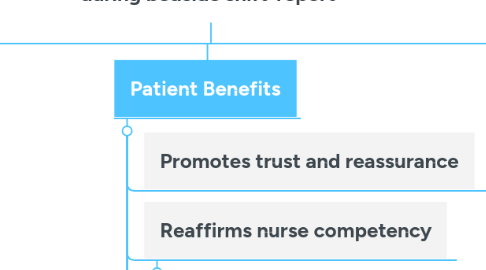
1. Nurse Barriers
1.1. Fear of accountability
1.1.1. Lack of role-clarification
1.1.2. Accountability ends/begins in unclear line
1.2. Lack of confidence
1.3. Resistance
1.3.1. Perception that bedside reporting is hard
1.4. Confidentiality issues
1.4.1. Blur out names
1.4.2. Dispose of identifying information appropriately
1.4.3. Ask patient if they want family present
1.4.4. Be considerate of patients in shared rooms and hallways when sharing health information
1.5. Lack of a shared vision
1.5.1. Negative attitudes
1.5.2. Lack of interest
1.6. Disturbances
1.7. Lengthy reports
1.8. Multitasking
1.9. Medical jargon
1.10. Repeated use of call-bells
1.11. Handovers at the nursing station/away from bedside
1.12. Busy
1.12.1. Lack of nurses around shift report
1.13. Language barriers
1.14. Inadequate training
1.14.1. For nurses to meet organizational requirements
1.14.2. Education of all staff and patients
1.14.3. Lack of organization policies and practices
1.15. Repetition of data
1.15.1. Inaccuracy
1.16. Poor time management
1.17. Locating different nurses during shift change
1.18. Lack of leadership
1.19. Not listening to subjective data
1.19.1. Listening demonstrates courtesy and respect
1.20. Limited communication
1.20.1. Do not limit shift report to patient
1.20.2. Promote open communication channels
2. Patient Barriers
2.1. Fatigue
2.2. Difficulty forming questions
2.3. Lack of encouragement
2.4. Language barriers
2.5. Focus on objective data
2.6. Rushing the process
2.7. Assuming patient's involvement/exclusion
2.8. Negative association with report
2.9. Medicalization
2.9.1. Medical jargon
2.9.2. Objective > Subjective data
2.10. Interruptions
3. Use of tools
3.1. Must be standardized
3.2. Must be evidence-based
3.3. Clear and concise
3.3.1. Broad and holistic, but succinct
3.4. Well-structured
3.5. Use current data supported by relevant history
3.6. Jean Watson's Carative Components in nurse-patient-nurse bedside reporting
3.6.1. Sensitivity to self and others
3.6.1.1. Humanity
3.6.1.2. Caring
3.6.2. Establish a helping, trusting relationship
3.6.3. Promote interpersonal teaching and learning
3.6.4. Provide a supportive environment
3.7. Agency policies and practices
3.7.1. SBAR
3.7.2. TOA Forms
3.7.3. Documentation
4. Nurse Benefits
4.1. Debrief/offload emotional burden
4.2. Clarify misunderstandings/ask questions
4.2.1. Improve anticipatory guidance
4.2.2. Reflection
4.2.3. Add missing information
4.3. Report is an educational opportunity
4.3.1. Continuous professional growth
4.3.2. Role-modelling behaviours
4.3.3. Advocacy
4.4. Proximity facilitates communication
4.4.1. Face-to-face interactions
4.4.2. Use of EMR for up-to-date infromation
4.4.3. Nurses are able to get more information from patients and families compared to doctors
4.4.4. Improve "closeness" to patient
4.4.5. Include other people involved in care
4.5. Collaboration
4.5.1. Teamwork among nurses
5. Patient Benefits
5.1. Promotes trust and reassurance
5.2. Reaffirms nurse competency
5.2.1. Improve feelings of safety under nursing care
5.3. Feel included and an active participant in their own care
5.3.1. Long-term
5.3.2. Short-term
5.4. Empowering
5.5. Inclusion of patient and family can improve treatment compliance
5.5.1. Overcome language barriers
5.5.2. Meet patient needs
5.6. Demonstrate caring aspects of nursing
5.6.1. Sensitivity
5.6.2. Treat patients with respect and dignity
5.6.3. Facilitates trusting relationships

